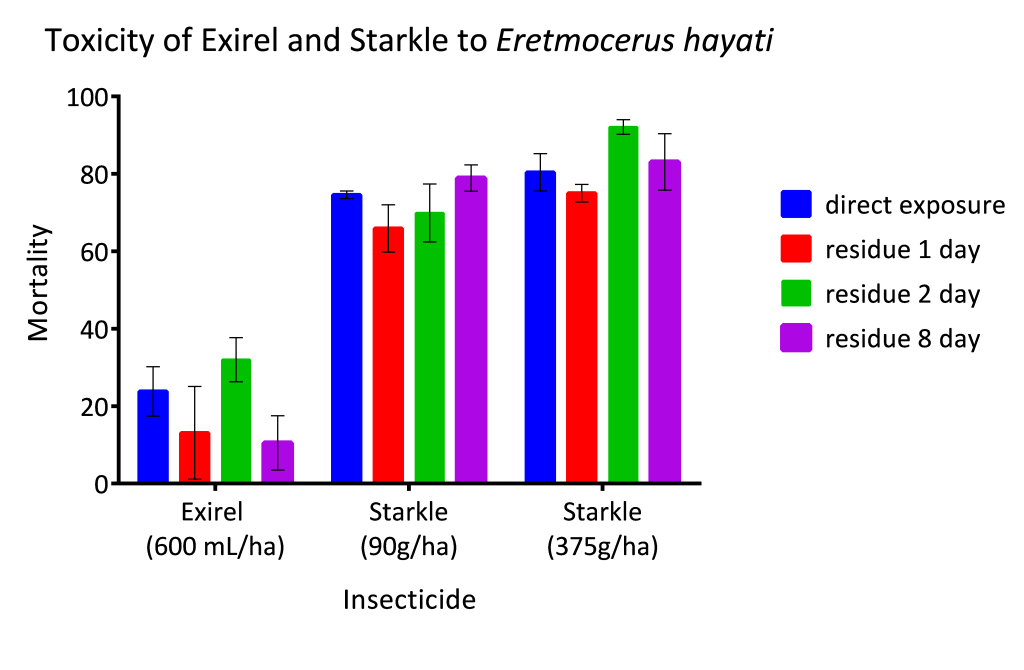Two new insecticides have recently been registered to control Bemisia tabaci B-biotype in cotton.
| Product | Insecticide group | Active ingredient | Pest |
| Exirel® | anthranilic diamide (Group 28) | cyantraniliprole | SLW, Helicoverpa, cotton aphid (suppression only) |
| Starkle® | neonicotinoid (Group 4A) | dinotefuran | SLW & green mirid |
Exirel® was registered for cotton use in the 2013/14 season, and Starkle® has been registered for the current cotton season for ground rig application only.
As part of the Cotton Research and Development Cooperation (CRDC)-funded silverleaf whitefly resistance project (DAQ 1403) we have conducted baseline susceptibility testing with both products. Baseline testing is a critical first step in the ongoing monitoring of SLW susceptibility (and resistance) to insecticides. We have been testing field populations for evidence of resistance to Exirel® for the past 2 years. To date there is no evidence of resistance to Exirel®. However, following both the label recommendations and the cotton IRMS are necessary to minimise the risk of resistance developing.
Cross-resistance risk
Whether SLW’s resistance to other neonicotinoids means that use of Starkle® comes with an increased resistance risk is unknown as the chemistry of this group is very complex and cross-resistance is not always predictable. For example, a strain resistant to Actara® (thiamethoxam, a neonicotinoid) has no cross-resistance to another neonicotinoid acetamiprid (Intruder®, Acetam®, Cobra®, Primal®), but an acetamiprid resistant strain can have high cross resistance to thiamethoxam.
Minimising the risk of resistance developing
It is good resistance management practice to avoid using another neonicotinoid for SLW control (e.g.Starkle®) if a neonicotinoid has been recently applied for mirid or aphid control (e.g. Shield).
Likewise, keep in mind that Exirel® used for SLW control, and Altacor® used for Lepidopteran pests control, are in the same mode of action group (Group 28). In addition, the registration of Voliam-Flexi® which contains both a Group 28 and a neonicitinoid (chlorantraniliprole and thiamethoxam) makes it even more important to know which mode of action groups you are using.
Impact on Eretomocerus hayati
Eretmocerus hayati is an introduced parasitoid of SLW that is now well established in cotton production regions. This tiny wasp plays an important role in suppressing SLW populations throughout the cropping season. Based on the Cotton Pest Management Guide’s Impact of insecticides table, both Exirel® and Starkle® have a moderate impact overall on a range of natural enemies. However, in our experiments specifically testing insecticide toxicity on Eretmocerus hayati we found the impact of Exirel® was low, and that of Starkle® was very high (see figure below).
Fit with the SLW threshold matrix The SLW threshold matrix is a decision support tool based on rates of population increase relative to the accumulation of day degrees and crop development. For further information refer to the Cotton Pest Management Guide for 2015–16.
While Exirel® is fast acting (nymphs stop feeding almost immediately), death may take 3-5 days. It is more effective on early developing nymphal populations than adults so is suitable for use in Zones 2 and 3B, and to a lesser extent Zone 3C.
Starkle® is a fast acting insecticide effective on both adults and nymphs, with death occurring within 1 to 2 days. We suggest Starkle® use be confined to Zones 3B and 3C as the ‘hardness’ of Starkle® on the major biological control agent of SLW, E. hayati, is a reason to delay its use as long as possible.
Where possible, control of SLW should be achieved before Zone 3C as there is high risk of honeydew contamination of lint from later infestations.


